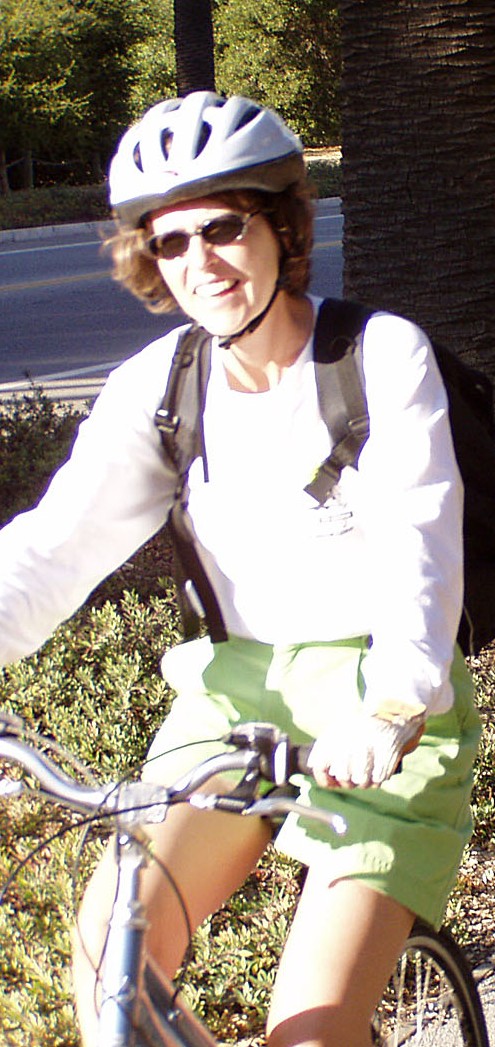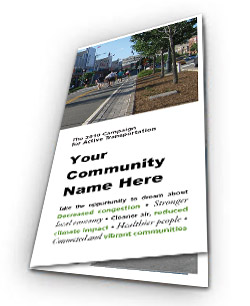ACTIVE TRANSPORTATION NEWSLETTER
Welcome to Rails-to-Trails Conservancy's Active Transportation Newsletter. This publication is a component of our 2010 Campaign for Active Transportation to double federal funding for trails, walking and biking by 2010. The emphasis is on securing focused investments in active transportation in dozens of communities across America. These newsletters highlight campaign activities, best practices, research and campaign organizing strategies.
|
Fact: |
| |
Nearly 90 percent of Americans believe new communities should be designed so we can walk more and drive less.
-Smart Growth America & National Association of Realtors |
Contents of this issue:
- New campaign resources: guidance document and brochure
- Share your local materials with RTC
- New research
- Profile: Hartford, Conn.
Please let us know if you have suggestions for a future issue.
1. New campaign resources: guidance document and brochure
Newly available resources on our campaign Web site (www.railstotrails.org/2010) to support your local efforts include:
- Campaign Guidance Document: This guide for your local campaign provides basic direction on building your campaign team, developing an active transportation case statement, and working with your elected officials. The guide also outlines RTC's roles and responsibilities, local strategies to consider and congressional assignments. While much of the material will flesh out or review information delivered at TrailLink 2007, new content of particular interest is the "'Application' to Congress" on pgs. 5-8.
- Campaign brochure: A customizable brochure for distribution at local meetings with stakeholders and the public.
Be sure to check the campaign Web site often, as content is frequently updated.
2. Share your local materials with RTC
Now that communities are hard at work developing their local plans and case statements, RTC will put your materials to work building national support for increased investment in active transportation. Please share your plans, findings, ideas and case statements so RTC can effectively persuade national opinion leaders and decision-makers of the importance of concentrated community investments in trails, walking and biking. Therefore, please e-mail kartik@railstotrails.org with:
- Bicycle and pedestrian master plans, or elements of your comprehensive plans that may reference bicycle and pedestrian efforts.
- Research studies or documents that make the case for walking and biking as transportation options.
- Local efforts and best practices to improve biking and walking. Such efforts can include new funding mechanisms, legislation / policy, or other public-outreach campaigns.
- Case statements demonstrating that federal transportation dollars would be well spent if invested in your local priorities. RTC needs your case statements by June 30, 2008. (See the Campaign Guidance Document for more information.)
As communities provide us with local practices, the campaign Web site will reflect instructive experiences and efforts.
3. New Research
Two new research items have recently been announced that relate to the 2010 Campaign for Active Transportation.
Published by Smart Growth America and the National Association of Realtors, the 2007 Growth and Transportation Survey presents interesting and encouraging trends in American thinking on transportation. Among the highlights:
- 21 percent of Americans believe that building new roads is the best solution for reducing traffic.
- 35 percent of Americans believe their community is doing an excellent or good job providing practical and convenient public transportation.
- 16 percent of Americans approve of gas tax increases to discourage driving as a solution to energy use.
- 84 percent of Americans oppose public road and highway privatization.
Additionally, in early December, the Brookings Institute announced the publication of The Option of Urbanism: Investing in a New American Dream by Christopher Leinberger. The study explores 30 metropolitan regions around the country and, based on the particular methodology utilized, comes to a surprising ranking of each region's number of walkable places per capita.
A field survey titled "Footloose and Fancy Free" (based on the book) notes, "metropolitan areas that are not seriously committed to building rail transit systems... may not have the option of walkable urban development due to slower economic growth and [a] weak tax base. These slow growing metropolitan areas without rail transit today may be at a competitive disadvantage regarding future economic growth."*
* emphasis added
More on this study, including a ranking of the 30 communities, is available here.
4. Profile: Hartford, Conn.
| |

Sandy Fry, Principal Transportation Planner, CRCOG
|
|
Hartford, Conn. is actively engaged in the 2010 Campaign for Active Transportation, says Sandy Fry, principal transportation planner at the regional MPO, Capital Region Council of Governments. The campaign’s monthly working group meetings are regularly attended by 15-20 of the 40 members, including the Central Connecticut Bicycle Alliance (CCBA), corporate interests, city and state agencies and AARP, among others.
The campaign has revitalized Hartford’s bicycle and pedestrian efforts. Fry notes, “The 2010 Campaign for Active Transportation has provided us with a framework to bring our bicycle and pedestrian plans to life, to rally support around bike and pedestrian projects, and to give voice to the region’s bicyclists and pedestrians. Plus, we’re having fun dreaming big dreams!”
Campaign efforts and successes of note include:
- A brochure was created to cultivate public interest around the campaign, capitalizing on local engagement in a community ride that drew more than 1,200 participants;
- A press release on the campaign, including statements of support from Aetna’s Chief Medical Officer and Saint Francis Hospital’s Senior Vice President;
- An online survey with more than 370 responses to date helps the working group capture public feedback on local needs;
- In response to a Clear Channel Communications radio talk show host who was quite vocal about his anti-bicycling stance, CCBA negotiated with the station to air Public Service Announcements encouraging individuals to share the road, and;
- Conversations with local funders to discuss supporting the campaign, positioning Hartford to leverage funding if the opportunity presents itself.
Conversely, the group has faced the following challenges:
- Determining the amount of information to present in vision documents and plans. The group is testing a two-tiered prioritization to outline its most valuable projects, and;
- Stakeholders often focus on possible federal funding as a panacea, failing to recognize that making trails, walking and biking a priority comes first. Subsequent public communications have therefore downplayed federal funding, instead relying on making the case arguments to generate local interest.
For more information on Hartford's efforts or details above, contact Sandy Fry.
To share local challenges or initiatives with the greater campaign community, send an e-mail to Kartik Srinivas.
Were you forwarded this e-mail? Start receiving these newsletters directly. Send an e-mail to kartik@railstotrails.org with "Subscribe 2010" in the subject line.
Be sure these messages don't get sent to your junk mail folder. Add activetransportation@railstotrails.org to your safe senders list in your address book.
Photo credit: Sandy Fry. © Sandy Fry.
Works cited:
Smart Growth America and National Association of Realtors. "2007 Growth and Transportation Survey." October, 2007.
Leinberger, Christopher. "Footloose and Fancy Free: A Field Survey of Walkable Urban Places in the Top 30 U.S. Metropolitan Areas." Brookings Institute, December 2007. | 


